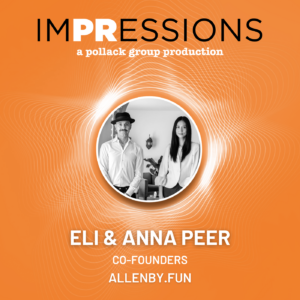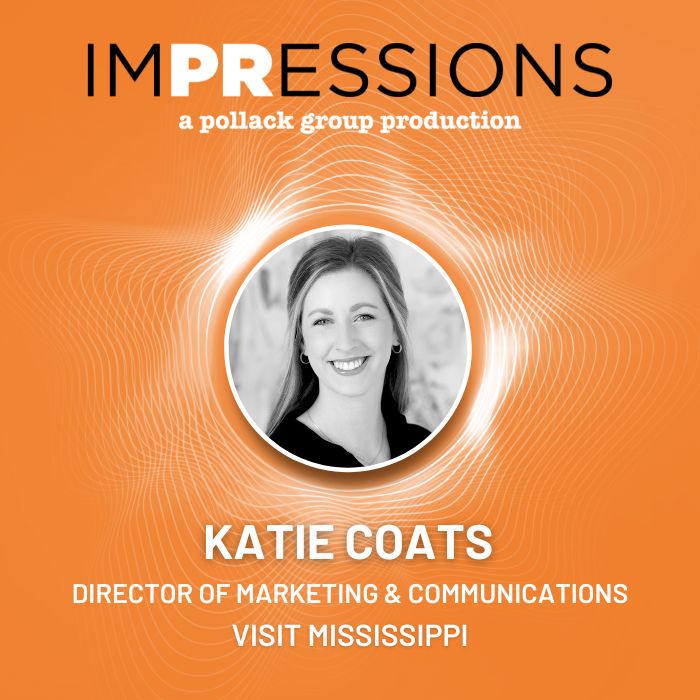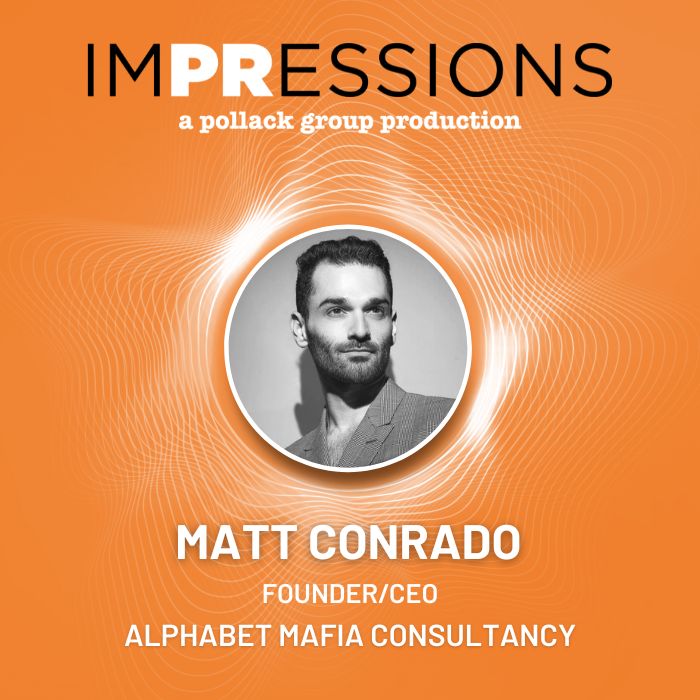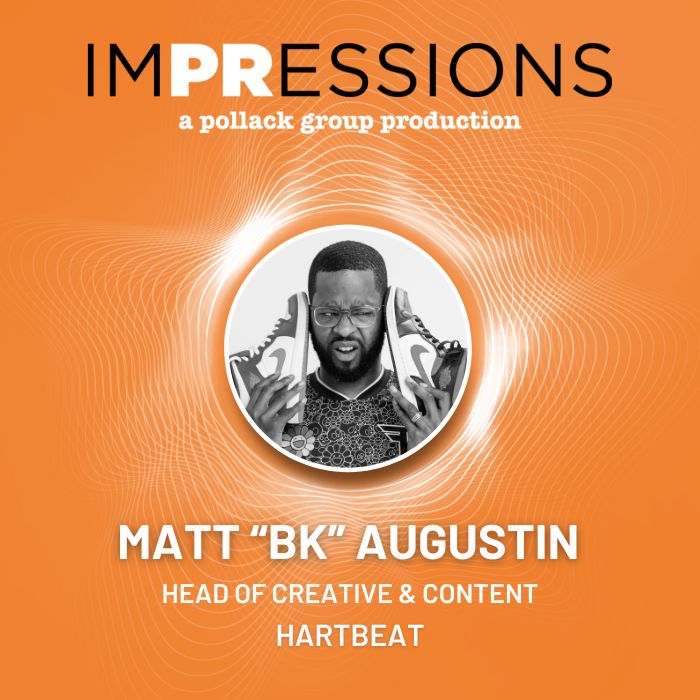 Through shared experiences, brands have evolved their marketing and begun focusing on how to evoke consumer emotions. Experiential marketing has become a unique and crucial tactic, creating meaningful memories that allow customers to connect on a deeper level with an organization. ImPRessions episode 16 dives into how to successfully execute an experiential marketing campaign with insight from Anna and Eli Peer, co-founders of Allenby.fun, with over two decades of experience as creative producers in marketing and branding.
Through shared experiences, brands have evolved their marketing and begun focusing on how to evoke consumer emotions. Experiential marketing has become a unique and crucial tactic, creating meaningful memories that allow customers to connect on a deeper level with an organization. ImPRessions episode 16 dives into how to successfully execute an experiential marketing campaign with insight from Anna and Eli Peer, co-founders of Allenby.fun, with over two decades of experience as creative producers in marketing and branding.
Impressions Episode #16 Transcript
Kalli: As time evolves, marketing professionals can all agree on one thing Consumers are smart. Gone are the days when a printed or generic social media campaign will garner interest from a brand’s core audience. Companies today need to get creative when speaking to their consumer base, and that is why many are opting to incorporate experiential marketing into their plans and strategies through shared experiences and creating campaigns that create meaningful memories many businesses are working to implement unique experiential marketing into their tactics. To discuss the evolution of the phenomena, we’re joined by Anna and Ellie Peer, co-founders of Allenby.Fun and Experts devising impactful marketing campaigns. Hi, Ellie and Anna. Thanks for coming to our show.
Anna: Hi. We’re happy to be here.
Eli: Yeah, Thank you for having us. It’s an honor.
Jenn: Its an Honor for us. So I’m going to dive in. Experiential marketing is a method in which a brand can promote its business or a product to consumers through an experience. That’s what sort of makes it so elite. How does this type of marketing differ compared to some other traditional forms?
Eli: The main thing is basically with experiential marketing, you are creating a contact with your customer. They’re experiencing your brand in the most personal way. It’s a full immersive experience. It can incorporate vision, sound, smells, flavors, collaborations. You’re basically asking your customers to join you, sometimes for minutes, sometimes for hours, into your own world that you create for them. No other media can incorporate such an immersive discussion with a customer like experiential. That’s the main thing. The main difference.
Kalli: So what are some examples in your experience of businesses truly capturing the essence of experiential marketing? Are there any particular campaigns that have come that come to mind that have blown you away?
Anna: I think for us, the experiences that tend to really capture our attention are not always necessarily the biggest productions with the highest dollar spend. What makes experiential really effective is having a creative concept that cleverly connects your core message and ethos to the people who are visiting that experience. So it can be as big as Red Bull starting with the [unclear] and asking their customers to build their own flying machines and then evolving into like the massive leader of extreme sports and going into space and not only evolving their brand, but also an entire industry adjacent to them. Or it can be something a little bit more intimate. If you look at the history of fashion houses, they all started with a very intimate experience within their atelier. The core of fashion was inviting their customers in into their world of Chanel or, you know, Louis Vuitton and having that personalized experience, which now obviously we have seen has grown exponentially, not only in the production of their runway shows as massive global events, but in additional experiential installations like taking over stores, doing their own pop-ups. Jacquemus had his bags as cars driving around the street, so they’ve really captured the essence of how to connect to their consumers and bring them into their unique world in small ways as well as large ways.
Eli: Fashion is a smart example because it’s one of the industries that a lot of the brands rely on experience before they rely on other platforms. Everything they do. Yes, it’s true in the end of the day, to create PR and social coverage and social pickup and social discussion. But they know how to use real-world engagement and have other platforms pick it up in such an amazing way. I don’t think there’s any other industry that uses experiential as well as an efficient as the fashion industry.
Jenn: Yeah, I completely agree. Especially when you said it’s more times like not the over-the-top campaigns that are the most effective. I worked in the music industry, and we did a big exponential marketing campaign for our products, and we would take over breweries across the US and bring our products for people to test drive. And it was something as simple as just bringing the gear, setting it up, buying our patrons a beer, and that was it. Mean we would have hundreds of people flock in. And this was back in the day when experiential marketing wasn’t even really a term to me was didn’t even realize like I was doing it then. So I completely agree with that. I’d love to know a little bit more about some of the campaigns that you’ve launched personally. There’s been quite a few, notably for SodaStream. What are some of your own personal experiential marketing initiatives you’ve loved that you’re most proud of?
Eli: Well, first of all, I’m a father that’s proud of all his daughters and sons, but there’s a few that I think will tell that story, even when I’m a very old man. One of them is the diner by Surface magazine. And David Rockwell, that is an amazing, actually story for experiential because when we were approached by Surface magazine, they wanted to celebrate the 24th year being alive as one of the United States leading design publications. So we built a concept to told them, Listen, the Salon Del Mobile, the design festival of the of the world, and you, of course, are over there always doing some talks and stuff like that. But you’re an American design publication. You should celebrate American design in the design capital of the world, Milan. And don’t just bring it as a show on pedestals. Bring some products from these designers and products from the other designers that American designers. Let’s build an experience that is so truly American. So for me as a non-American, I hope you can understand that by hearing my accent it will the American Diner symbolize everything that’s Americana. So many movies, Pulp Fiction, so many stories, so many music videos, artwork, embedded American Diner.
Jenn: So, so true.
Eli: So we want we said, let’s build the diner in Milan and have everything done there. From the design of the space to the food accessories, to the tablecloths, to the everything designed by American designers. And they agreed. So we they brought on board. David Rockwell is superstar, architect, designer, set builder for Broadway. You know, I can’t even express the genius of this man and his group. Then we found this abandoned bunker underneath the railway station, the main station in Milan that was basically a bunker for Mussolini and a hideout. And there was nothing there. It was a half circle, tubular space with no running water, no sewage, no anything. And we built there a diner that was open for seven days. It served breakfast, lunch, dinner and after party with the famous teacher every night. And the mayor of Milan asked Surface to keep it there for good because it brought an amazing crowd to an area in Milan that was at night, not the nicest places to be, and now it’s forming actually. So that was the start of making the railway the main station in Milan, to a cool area of Milan again. But it was collaborating with so many different stakeholders. You had surface, your [unclear], your two by four that helped with the branding and the branding the entity, and then you have every designer that from bringing a chair to bring to designing the neon signs, to bringing the plates and also food, getting water there. There’s no water getting sewage there.
Anna: We built a full functioning restaurant, kitchen.
Eli: Getting the city health fire department, everybody to sign it off. So and it and we want best of the best engagement activation during Salone del Mobile that year and that was one of my pinnacle achievements in my career. I think I had such a good time doing it.
Anna: Yeah, it was so fun because it utilized sort of all of the things we had learned throughout the years and then pushed us to create really imaginative and outside the box things that we never even knew were possible. So it was a great culmination.
Jenn: Yeah, it sounds amazing. And I’m curious, you said that it was only supposed to be open a week. How long was the diner open for?
Eli: A week. The city wanted it to stay.
Jenn: Oh, I see
Eli: But they wanted us to operate it. We could not operate it. It was like we all live in the United States, so we took it apart. And after a week and. Yeah, and we. Whatever we can save and brought back to the designers, we did, and we saved a lot of the parts. And I think it even it’s even today used in a bar in New York they rebuilt parts of it in a bar in New York.
Kalli: That’s so amazing. Yeah. And just like really cool. And, you know, it’s something it’s so it’s really taking an idea as simple as a diner, but like, making it the coolest thing and taking it to, like, to such a different level. That’s that’s really amazing. And definitely, I agree that, that if I were you, that would be my proudest moment too.
Eli: Yeah, it’s all about bringing a building, a concept that people will want to consume. Yeah, the Italians and Europeans, you know, they are like me. They’re fascinated with Americana. You Americans take the diner for granted. It’s part of their daily lives. They see the greasy diner on the corner every day. They even refuse to go in. But bringing a diner to showcase American design and making the most beautiful diner you ever seen. That’s a good concept that I’m proud that it came from our agency.
Kalli: Well, as a diner-loving American. Thank you for Spreading it.
Jenn: We definitely fit the American persona of loving a good diner.
Kalli: And so outside of, you know, having running water, what are some key factors that a brand needs to determine before they’re able to leverage an experiential marketing campaign, you know, to even mirror some of the success that you’ve had?
Anna: I think the main thing that we come up with when clients approach us, and they say, okay, I think we need to do something experiential, that people are talking about it. And you know, there’s this event that’s coming up in a month, like think we should be part of that when there isn’t enough time and planning to make it part of your marketing strategy and overall budget. It can maybe not result in the best activation. The one thing we want to be sure of when people come to us and want to engage in some experiential installations is that it’s part of their marketing strategy as a whole. So there’s enough planning, enough time to really think about what the best creative is going to be for your brand at that time. So if you are launching a new product in Q two and we say, okay, we have enough time to plan something around that, and what makes sense with the campaign that surrounding that whole launch and to make it really a cohesive part of your storytelling, rather than think we need to do something experiential, let’s do it in three weeks, that usually will end up in something that can be done, but maybe not the best use of those marketing dollars. So we want to be sure that the goal for these experiential activations is to really engage with your community where they want to be utilizing, whether it’s food, music, just your products, whatever it is that we’re going to utilize, it makes sense for your brand, and it makes sense for those people that you want to engage.
Jenn: Absolutely. I think most brands, they get like the stars in their eyes, and they don’t realize just how much work is involved in creating a campaign like this, something of the stature of a diner in, you know, Europe. What I did, we took over breweries across the United States. That wasn’t an overnight idea. There are so many conceptual variables that go into it that people don’t realize because they just see the end result.
Anna: Exactly.
Jenn: So I want to ask about social media, because that plays a pretty constant variable when it comes to any type of marketing, especially experiential marketing. So how do the two support and coincide with each other today?
Eli: I don’t like even using the different terms today. I think today you have “marketing” and you have to consider that any campaign that you do needs to be picked up. By all platforms and what it’s like PR is PR just putting ads in daily newspapers. We all know that it’s not. It’s much, much more socialist. Part of PR bloggers are part of PR influencers are part of PR, digital platforms, print platforms, and maybe other platforms that I didn’t even mention are all part of PR, and they’re also part of experiential. You have to take today. Think of it as marketing is basically one word. There’s no platforms. You come. You need to come with a campaign that we know how to evolve and hold a discussion and be an interesting story that wants to be read or heard on all platforms. Experiential can assist in engaging in a much more deeper sense. It’s more expensive per engagement, of course, you know, you can get cheaper engagements on Instagram, but the engagement is much, much deeper.
Anna: Yeah. And you know, obviously when you develop an experiential campaign, you want to have elements in it that people are so connected to that they want to share it, they are excited that they were there and they got to see that in person. So they want to share it on their social media. And they, you know, whether it’s that photo op moment or just saying how fantastic the concert was or whatever moment that they want to share with their own community, that we provide that deep of a connection that they really do authentically want to share it with their own community.
Kalli: That makes a lot of sense. And especially in today’s world, everything is so connected and you know, you’re sharing things right away. So, you know, you’re able to bring these events and tell everyone where you went and what you did. Kind of speaking of that type of success, what is it that you think makes experiential marketing successful? And, you know, really, what are some of the variables that brands should be aware of when they’re planning a campaign of their own?
Anna: It kind of goes off of that same vein where you really want it to feel authentic to your brand, your brand’s ethos, whatever story you’re telling during that time period, and feel unique. So I think absolutely having enough time to do the correct planning, develop the creative, produce the elements all beautifully, that allows you to create an activation correctly. You know, a lot of times you’ll see sort of this piggyback or copycat experiential trends happening. Not that long ago, every brand was having their branded food truck all over and, you know, giving out free food. That may work for some brands, possibly restaurants or, you know, something that has a connection to food. But it didn’t necessarily have a connection to all brands that were doing it. So while maybe some people will take a picture in front of that branded food truck, what are they taking away? What is the experience that they’re leaving with the feeling about your brand that they’re leaving with after that interaction? If it was just to come and get a free burger, that may not leave any impression about your brand with them, right?
Jenn: Who’s going to say no?
Anna: Yeah.
Eli: And it’s not just the people that were in the activation. Now, you took a photo, you put it on your Facebook or your Instagram or your TikTok, and what those viewers are taking away that you were in front of a nice branded Airstream. So the experience needs to follow through by the person experiencing it and the people watching him or her experience it. So the message needs to be very clear and always on brand.
Jenn: Yeah and it needs to invoke an emotion, I think, to you know, like you said, anybody can go and say, yeah, I’ll take a free slider that this food truck is giving out. I didn’t have lunch today. Sounds great, or yeah, I’ll do a free beer that this brewery is giving out, but there’s no emotion there that you’re just fulfilling a need for somebody wanting to come by and get a free sample. But there needs to be so much more to that. You did a great job of telling us what a brand needs to do when they want to create some type of experience and marketing campaign. But what are something companies should not do? Do you have any advice for brands if they maybe not too familiar with experiential marketing, something that they should look out for if they’re doing their first event per se?
Anna: I think the biggest sort of not mistake but misstep is when brands kind of tiptoe into the world of experiences and say, well, let’s start with a small budget. So we can do, you know, maybe this thing here that we’ve seen everybody else doing to give it a try, but there isn’t the creative behind it. And oftentimes they may think a small budget means a small idea and we think the opposite.
I think a small budget does not have to mean a minimal idea or a minimal connection. You can create a really meaningful connection with your audience and maybe with people that you haven’t connected with before by coming up with a really creative and clever way to show them who you are as a brand. That may be through a collaboration. Even a small business can maybe find another small business around them that they have similar ethos and they have a similar community, and they can share together and join to join forces and create a unique experience without spending a lot of money. The idea that a small budget means you’re going to have a small engagement is not always correct, and the main thing behind that is coming up with the creative and allowing yourself to think outside the box. And we love doing that. We love coming up with brand partnerships that are maybe not obvious, but give your consumers a new way of looking at you by seeing how you partner with this other brand. So we find that to be a really effective way of utilizing maybe not the biggest budget for experiential and starting out. That’s the one thing that I really like to tell clients is that you know, having a small budget doesn’t mean you have to have a small idea.
Kalli: Yeah, I agree with that. I think, you know, it’s just because you can’t spend big doesn’t mean you can’t think big.
Anna: Yes. And if you’re spending the money, you want it to be effective. Otherwise, it’s wasted marketing dollars. You could have just put that back into paid media. I was just going to say, going to do experiential. Have it be meaningful.
Jenn: Yeah, a big idea or a big budget doesn’t necessarily mean that people are going to resonate with it.
Anna: Exactly.
Eli: Yes. And even companies that were built on only online sales, almost 90% online, said, let’s take Casper, the mattress company, they’re an online business, but they also do brick and mortar experiences, either if it’s pop-up stores that you can come lay on the mattress or pop-up beds, mini rooms in airports and lounges that you can come have a nap between your flights and experience the Casper mattresses. So even companies that are completely online, direct to consumer, using most of the budget to promote themselves online understand that they need to create that touch, that interface, that connection with their customers, that they were not successful in bringing them online, that they needed another touchpoint with that customer to get them into the Casper world.
Kalli: Yeah, that’s such a good point. And, you know, I think it’s been proven through just in this conversation, the campaigns that we’ve talked about that, you know, traditional marketing strategies are antiquated, and brands really need to get creative when it comes to retaining loyal customers and finding new audiences. Eli and Anna, you’re certainly creating a movement in this space, and we’re extremely grateful for your time today.
Anna: Thank you so much. We appreciate it.
Eli: Yes, thank you very much.
Kalli: For our listeners, if you’ve got a question or want to drop by and say hello, you know where to reach us. Email any time at imPRessions@pollackgroup.com.






